Focus group reaction
Focus Group Questions
James
Matt
Jack
For my documentary i created several questions for a focus group relating to my documentary giving me feedback on what was successful and what needed improving.
Tuesday, 28 April 2015
Wednesday, 11 March 2015
Unit 27.3 Be able to plan and research a factual programme for television: Evaluation
For my Level 3 BTEC Media assignment i had to create a factual TV programme using a documentary format by using the codes and conventions of a factual documentary, This included using techniques such as Interviews, Cutaways and sequences to form the structure of my documentary. The title of my documentary is 'A Day In The Life Of A Pianist', The documentary was a human interest documentary which followed a journey style structure due to it following an individual person and his life as a pianist. Throughout my documentary i used an interview to give the audience an insight into Lewis's life as a pianist whilst using cutaways of him playing the piano and of his college (Chethams School of Music) to illustrate what he is saying during the interview. I also used sequences of various shots of lewis playing the piano at the beginning of my documentary and at the end to make the documentary more interesting and so that it gives the documentary a more fluent structure and make the beginning and end correlate/correspond with each other to give the documentary a feeling of closure for the audience when the documentary has finished.
For me to begin filming i had to fill in my pre-production paperwork which included call sheets, Recces, Actor release forms, Production schedule, Storyboards, Shooting schedule, Shot list, and Tape log. The production paperwork helped me plan and formulate the structure of my documentary so that during filming and editing i didn't become confused to what i have or have not done but instead created a plan for me to follow. The production schedule and shooting schedule helped me keep track of when i had to film due to the production schedule giving me the information of start and finishing dates of this project making sure i kept within that schedule and had enough time to film and edit my documentary and the shooting schedule giving me the dates of when i went filming which made sure i stuck to those dates so i had everything filmed before i had to begin editing therefore giving me enough time for me to finish everything before the documentary was due in. The call sheets helped me know who was going to be helping during filming on a particular day such as the production team and actor, the Recces were sheets that gave me information on the locations i was going to film at such as the lighting and equipment i was going to use at each location, the Actor release forms gave me permission for Lewis to be used in this documentary due to him signing the actor release form to say he was okay with him to be used in this documentary, and the storyboards and shot list helped plan the structure and types of footage i was going to use during my documentary.
The first stage of forming and creating my documentary was filming the variety of different shots for the documentary which was to film an interview with Lewis talking about his life as an aspiring professional pianist and cutaways of Lewis playing the piano at his house which i also used in a sequence towards the beginning and end of my documentary to give the documentary a more fluent structure and make the beginning and end correlate with each other to give the documentary a feeling of closure for the audience when the documentary has finished and give the documentary are more authentic visual feeling such as giving the audience something interesting to watch. I chose to film at this location to give the audience a better insight into where Lewis practices and so the audience can connect with Lewis on a personal level due to me wanting to give the feeling of letting the audience in on how he conducts his social life around the piano and his time practicing the piano which i did by filming at his house making the audience feel he has let them into his life for the duration of the documentary. I filmed the interview at Lewis's house also so that he felt more comfortable and relaxed during the interview due to there being no disruptions from the public or any background noises that could cause Lewis to become distracted or uncomfortable and that he was in a familiar environment and place that he could feel content in. I also went and filmed at Chethams School of Music to get cutaways that were placed over the interview to visualise what Lewis is saying such as placing the footage of Chethams over information of the college that Lewis is giving me. I chose to film at Chethams due to it being the college Lewis attends and being a crucial part of Lewis's life and a major part of his progression to becoming a professional concert pianist. The cutaways of Chethams were also used to keep the documentary entertaining instead of just having a constant interview through out but to give the audience something to look at and to see what Lewis is talking about. All of the filming was successful as the weather was clear and sunny on both days with no interruptions or distraction from the public.
The majority of filming my documentary was successful with only minor faults, During filming i encountered difficulties with lighting and editing. The problems i had with the lighting was during filming the cutaways of Lewis playing the piano the lighting was a little to dark on some of the shots such as the long shots of Lewis playing the piano, due to the room not letting enough light in causing the footage to look dark, although the footage was slightly dark it wasn't enough for the footage to be unusable for the documentary as you could still see what was happening during that footage which i used at the end of the documentary in the credit sequence and as cutaways over the interview. Another problem with lighting i had was during filming footage of Chethams the camera had light reflecting off it from the sun causing lens flare on some of the low angle shots of the college therefore resulting in the footage becoming unusable for the documentary, due to this happening i got more footage of the college from various different angles where there wasn't any reflections from the sun or other lighting. The footage i got from the cutaways in Lewis's house involved various different close ups of Lewis's hands on the piano and a variety of mid-shots and Long shots of Lewis in the piano by using a tripod with the camera attached to achieve these different shots without the footage becoming shaky resulting in very successful shots that i was able to use during my documentary. The interview was framed with Lewis to the right of the camera so that when the audience watch my documentary they feel as though it is authentic and so that it looks like a near professional standard documentary. The types of shots i filmed of Chethams school of music were long shots and low angle shots of the college to give the audience an idea of what the college looks and feel like due to the shots making the building seem powerful and important. Another technique i used when filming at Chethams was panning the camera from the left of the college to the right, i chose to do this because i wanted the audience to see the whole of the building in one shot rather than editing different shots together to create a single of the college which could result in jump cuts that would look awful. Another reason i chose to pan was to show the audience the size and scale of the building and to keep the audience entertained when watching rather than just have the audience watch shots that stay in the same place creating a monotonous feeling to the documentary.
The next stage after filming was editing the footage to create my documentary. I edited my documentary in Final Cut Express and took me two weeks to edit all of my documentary. The editing was the most difficult part of producing this documentary due to me encountering the most problems and difficulties during this process. The first part of editing was to create sequence at the beginning of the documentary which involved putting three pieces of footage together to form a sequence, The sequence was of Lewis playing one piece of music on the piano, the first shot was a close up of his hands followed by a shot of his feet then a over the shoulder shot of Lewis which i then added the title over the footage whilst Lewis was still playing the piano. I chose to place the sequence at the beginning to entice the audience in to carry on watching the documentary and create the basis of what the documentary will be about. The difficulties i had with this was matching the audio with the footage due to the audio being recorded separately to the footage so that it appears clearer on the finished documentary. It took me a while too match then audio with the footage by cutting the footage of lewis down to size then placing the audio over the top but i finally managed to achieve this and it worked and matched up well. I then added the interview footage after the first sequence keeping the music over the interview footage but quietening the music down which i kept going throughout the documentary. The problem i had with editing the interview was that it was too long (12 minutes) therefore i had to cut the footage down which involved removing parts of the footage to meet the required length of the documentary (7 minutes) that resulted in noticeable jump cuts throughout the documentary when transitioning between questions i ask Lewis, To cover up these jump cuts i used various different cutaways over the cuts to distract the audiences attention away from the jump cuts, although i did this with the majority of the jump cuts there were still some that were noticeable due to not having the correct or enough footage to place over the top of them such as Lewis talking about something other than the college which if i used the cutaways i had would not of made sense and there would of been multiple shots of the same piece of footage which would not have worked well in the documentary as they would only be there to cover up the jump cuts, Another way i covered up the jump cuts was to place transitions between the different questions i asked Lewis as a way to keep the documentary smooth and flowing whilst still covering up the jump cuts. The final problem i had during editing was adjusting sound levels on the music which i placed over the interview footage, This was a problem due to the sound either being too loud or quiet in some areas of the documentary which sometimes over powered Lewis's answers during the interview. I finally managed to prevent the audio being too loud or quiet by adjusting the sound levels too an appropriate level in areas which i felt didn't sound right finishing with perfect sound throughout the documentary. I chose to place the music over the interview footage to make the documentary more engrossing and entertaining for the audience.
To get feedback for my documentary i had a focus group of three people to watch my documentary and answer questions about what was successful about my documentary and what improvements could be me made. The majority of feedback was positive such as James saying my documentary was 'Professional and well made' which was the overall feedback from my focus group, From watching my documentary Jack said that 'Techniques and interviews were used very well in my documentary'. I also got feedback from my focus group saying that if i made my documentary 'less formal it would appeal to a younger audience' and also that i showed more of the college it would look better, but overall was a very well made documentary that would appeal to its intended audience.
Overall i believe the production of my documentary such as the filming and editing went successfully as i kept within the given time to create my documentary with everything completed with only minor difficulty that mostly occurred during the editing process. My finished documentary was also successful as i have included several codes and conventions of factual documentary film making including cut-aways, sequences and interviews that all work well in my documentary. The only problem that i can see within my documentary was the jump cuts during the mid section of the documentary that i covered up using transitions and cutaways to make them less noticeable but overall my documentary was successful.
To get feedback for my documentary i had a focus group of three people to watch my documentary and answer questions about what was successful about my documentary and what improvements could be me made. The majority of feedback was positive such as James saying my documentary was 'Professional and well made' which was the overall feedback from my focus group, From watching my documentary Jack said that 'Techniques and interviews were used very well in my documentary'. I also got feedback from my focus group saying that if i made my documentary 'less formal it would appeal to a younger audience' and also that i showed more of the college it would look better, but overall was a very well made documentary that would appeal to its intended audience.
Overall i believe the production of my documentary such as the filming and editing went successfully as i kept within the given time to create my documentary with everything completed with only minor difficulty that mostly occurred during the editing process. My finished documentary was also successful as i have included several codes and conventions of factual documentary film making including cut-aways, sequences and interviews that all work well in my documentary. The only problem that i can see within my documentary was the jump cuts during the mid section of the documentary that i covered up using transitions and cutaways to make them less noticeable but overall my documentary was successful.
Tuesday, 10 March 2015
Tuesday, 3 March 2015
Unit 27.3 Be able to plan and research a factual programme for television: Tape Log
For my production paper work i have produced a Tape log which shows all the individual footage i have taken and and whether they where successful or not. The Tape Log also shows the length of each shot and the content that is in them.
Wednesday, 25 February 2015
Unit 27.3 Be able to plan and research a factual programme for television: Personal production log 2
21st February 2015
During todays filming we completed filming cutaway footage of Chethams school of music which involved various techniques such as panning with the camera to get numerous exterior shots of the college which will be used during my documentary to illustrate what Lewis is saying in his interview. We encountered no problems during filming as we got everything that we needed filmed within within the day and the times scheduled due to the trains into Manchester being on time and not encountering any problems or distractions. Areas for improvement would be to try and attempt to film on a quite day when it is less busy due to some of the footage having people walk in front of the camera which is only a minor problem but overall filming was successful without any major problems or faults.
During todays filming we completed filming cutaway footage of Chethams school of music which involved various techniques such as panning with the camera to get numerous exterior shots of the college which will be used during my documentary to illustrate what Lewis is saying in his interview. We encountered no problems during filming as we got everything that we needed filmed within within the day and the times scheduled due to the trains into Manchester being on time and not encountering any problems or distractions. Areas for improvement would be to try and attempt to film on a quite day when it is less busy due to some of the footage having people walk in front of the camera which is only a minor problem but overall filming was successful without any major problems or faults.
Wednesday, 18 February 2015
Unit 27.3 Be able to plan and research a factual programme for television: Personal production log
18th February 2015
During todays filming we completed two major tasks, the first task being to film observational and cutaway footage of Lewis playing the piano and the second task being filming an interview with Lewis. I only encountered minor problems when i was filming such as the audio being to quiet when filming the interview. The problem was solved by using a mic to pick up the sounds the camera was unable to pick up therefore resulting in better sound quality. Overall filming went very well and smoothly due to all filming being completed within the scheduled filming time with only minor problems that were solved quickly and easily. Areas for improvement are to make the audio better quality and lot more clearer by using a mic when filming so that the sound quality is good. Another area for improvement would be possibly try to film everything in a sequence so that i do not get confused when i am editing the such as getting the shots in the storyboard. The filming lasted for three hours where i managed to complete the majority of the filming without any major problems resulting in a successful day of filming.
During todays filming we completed two major tasks, the first task being to film observational and cutaway footage of Lewis playing the piano and the second task being filming an interview with Lewis. I only encountered minor problems when i was filming such as the audio being to quiet when filming the interview. The problem was solved by using a mic to pick up the sounds the camera was unable to pick up therefore resulting in better sound quality. Overall filming went very well and smoothly due to all filming being completed within the scheduled filming time with only minor problems that were solved quickly and easily. Areas for improvement are to make the audio better quality and lot more clearer by using a mic when filming so that the sound quality is good. Another area for improvement would be possibly try to film everything in a sequence so that i do not get confused when i am editing the such as getting the shots in the storyboard. The filming lasted for three hours where i managed to complete the majority of the filming without any major problems resulting in a successful day of filming.
Unit 27.3 Be able to plan and research a factual programme for television: Week 3 Production log
During this week i wish to complete all of my filming for the documentary so that the following week i am able to edit all of my footage. On February 18th i hope to film cutaways and observational footage of Lewis playing the piano to illustrate what Lewis can play and the talent he has and i also hope to film an interview with Lewis.
I will also be filming on the 21st February in Manchester to get footage of Chethams School Of Music for cutaways.
I will also be filming on the 21st February in Manchester to get footage of Chethams School Of Music for cutaways.
Wednesday, 11 February 2015
Tuesday, 10 February 2015
Unit 27.3 Be able to plan and research a factual programme for television: Call Sheets
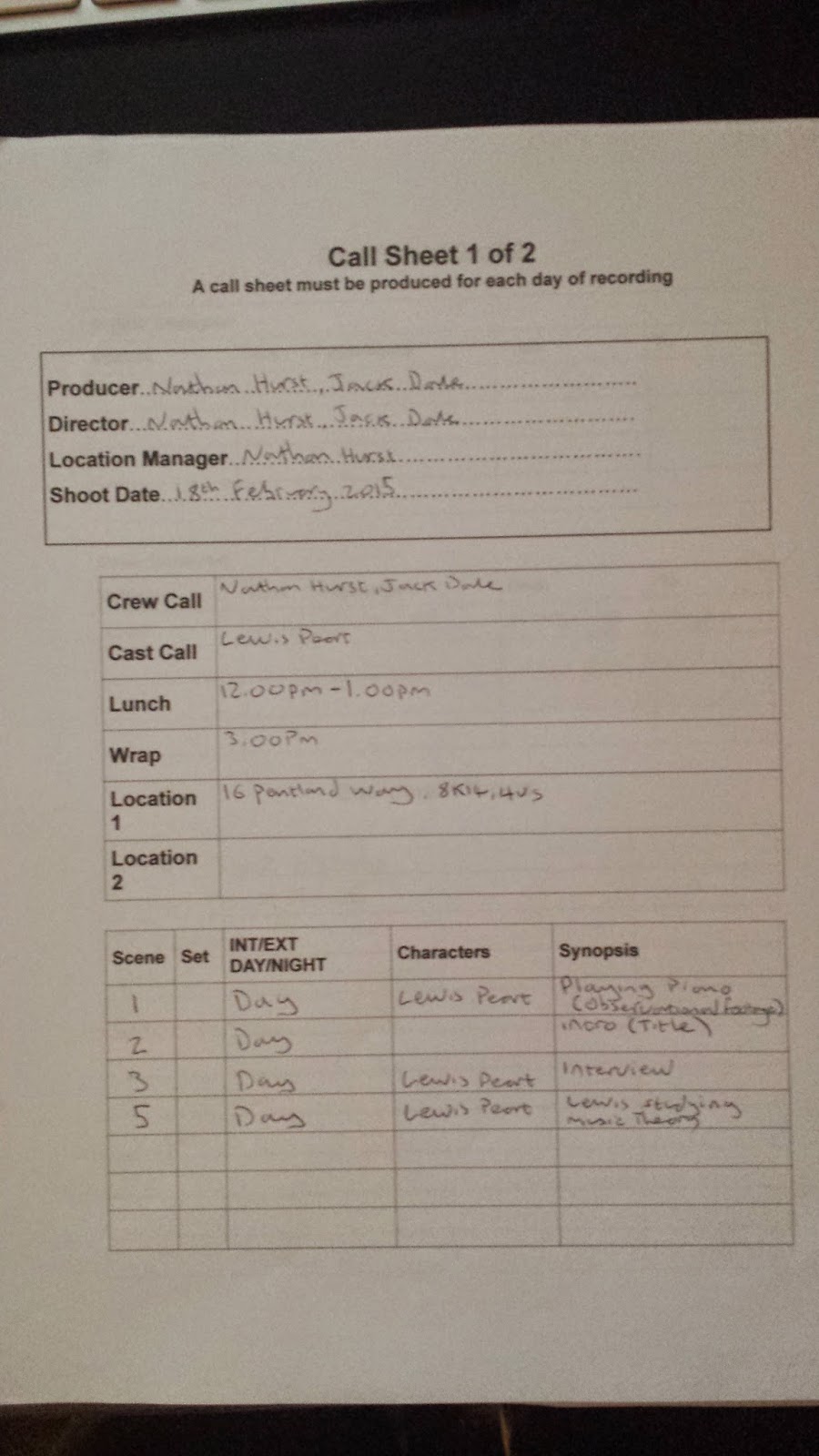
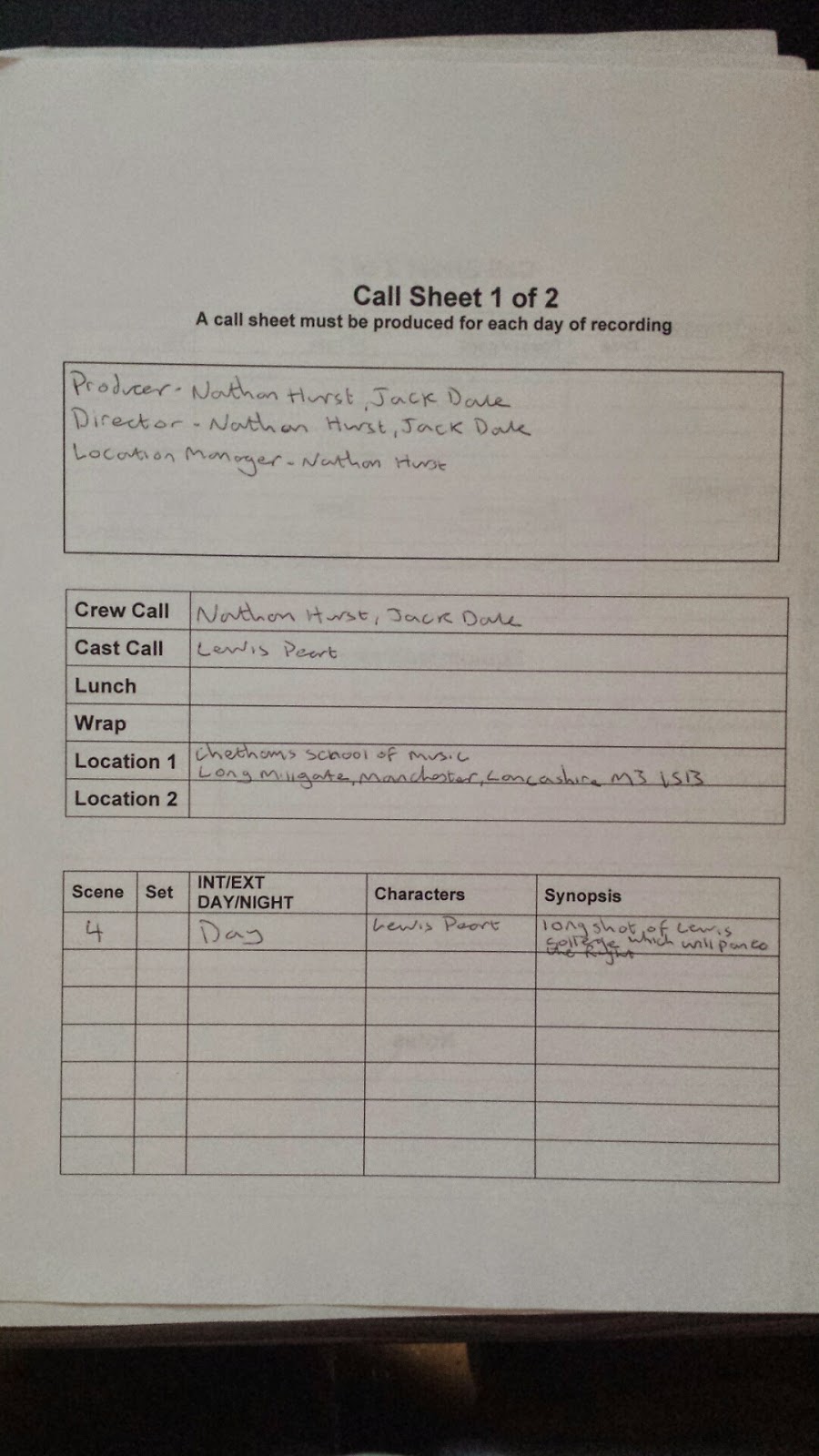
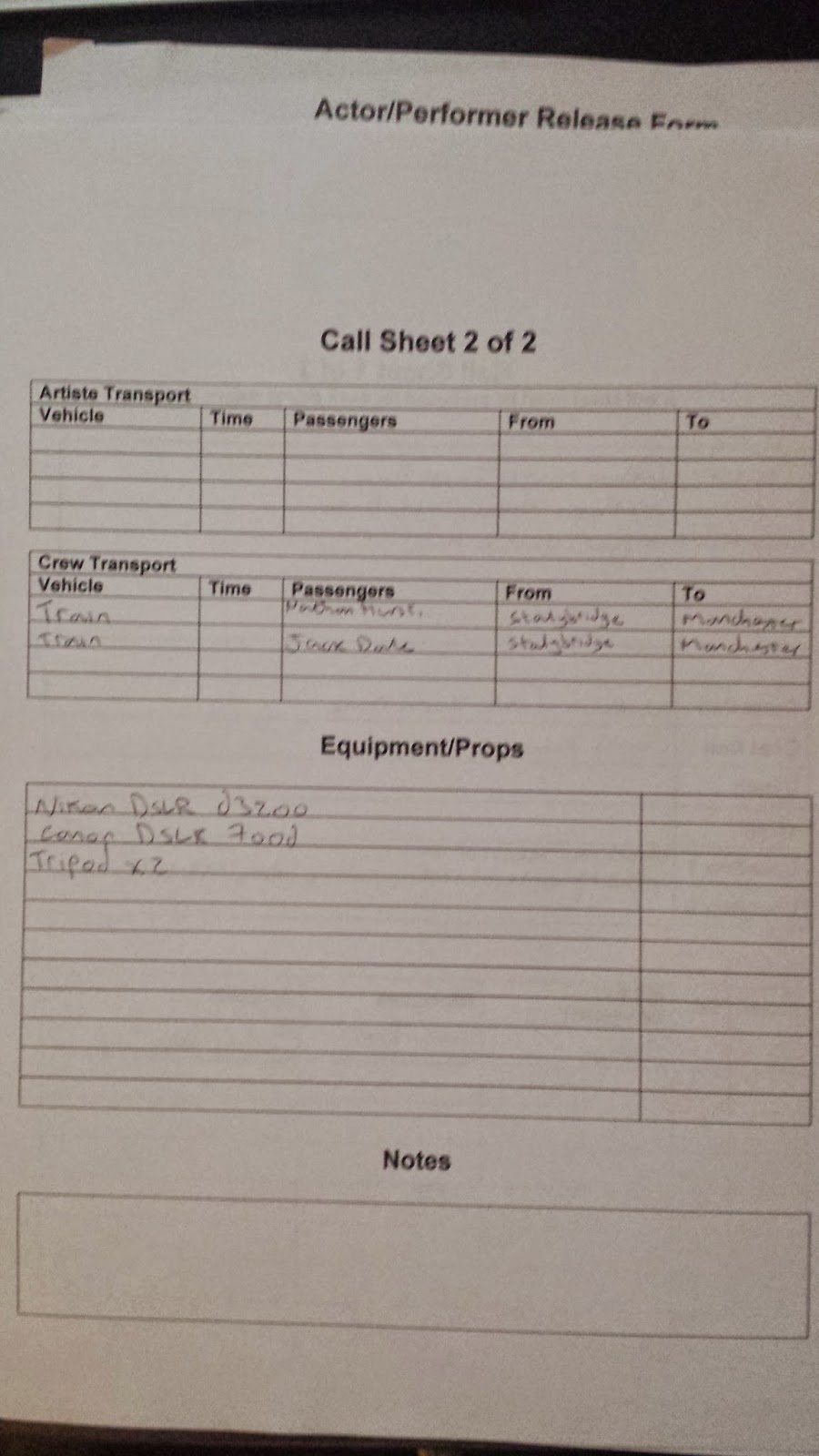
As part of my production paperwork i have produced a call sheet for each location, The first call sheet is for filming at 16 pentland way (Lewis's house) which has information on who will be at that location during filming, what we are filming there, transport, and what equipment we will be using. The second call sheet is for filming at Chethams school of music with the same information as the first call sheet for that particular location.
Unit 27.3 Be able to plan and research a factual programme for television: Risk Assessments
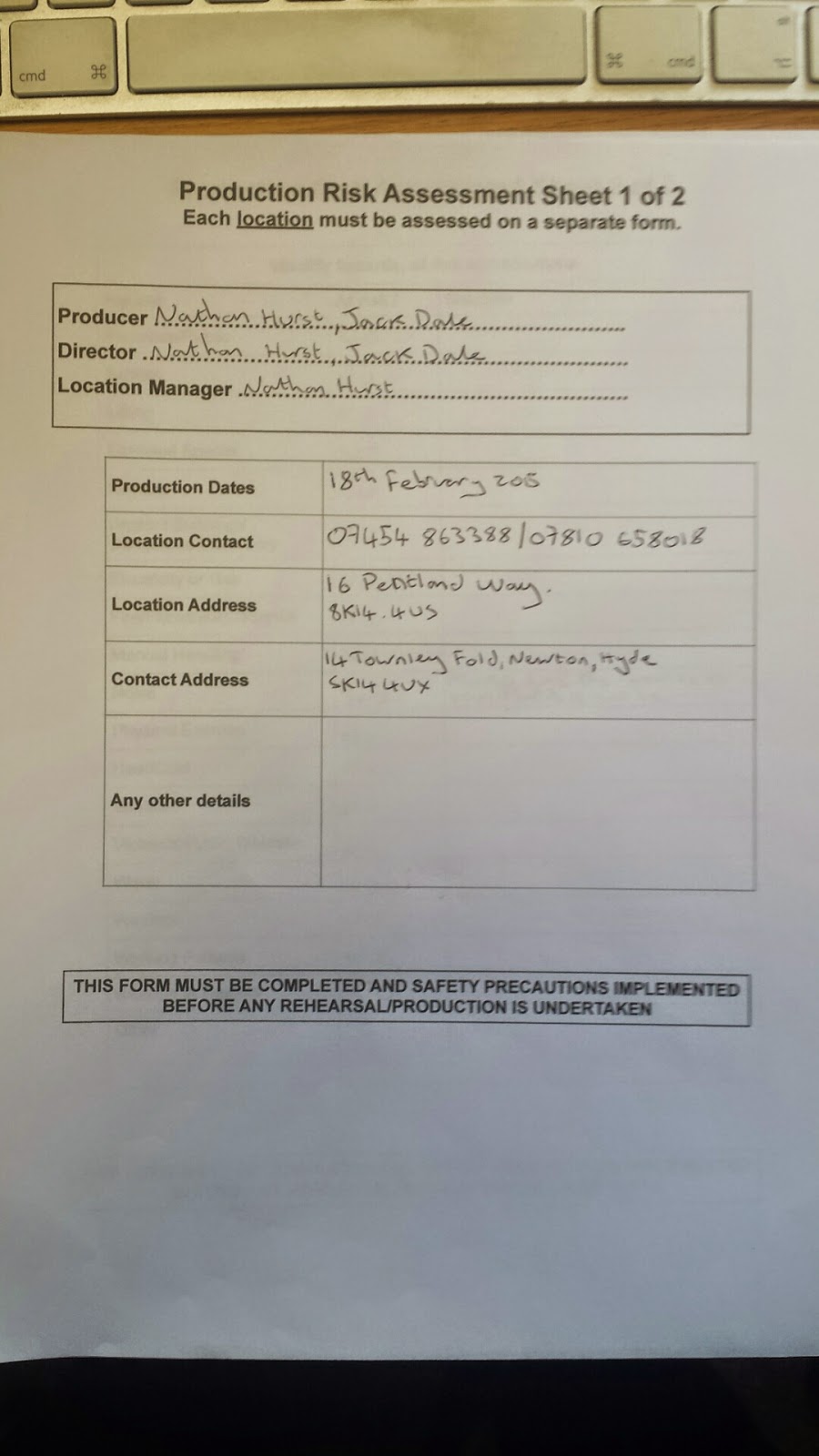
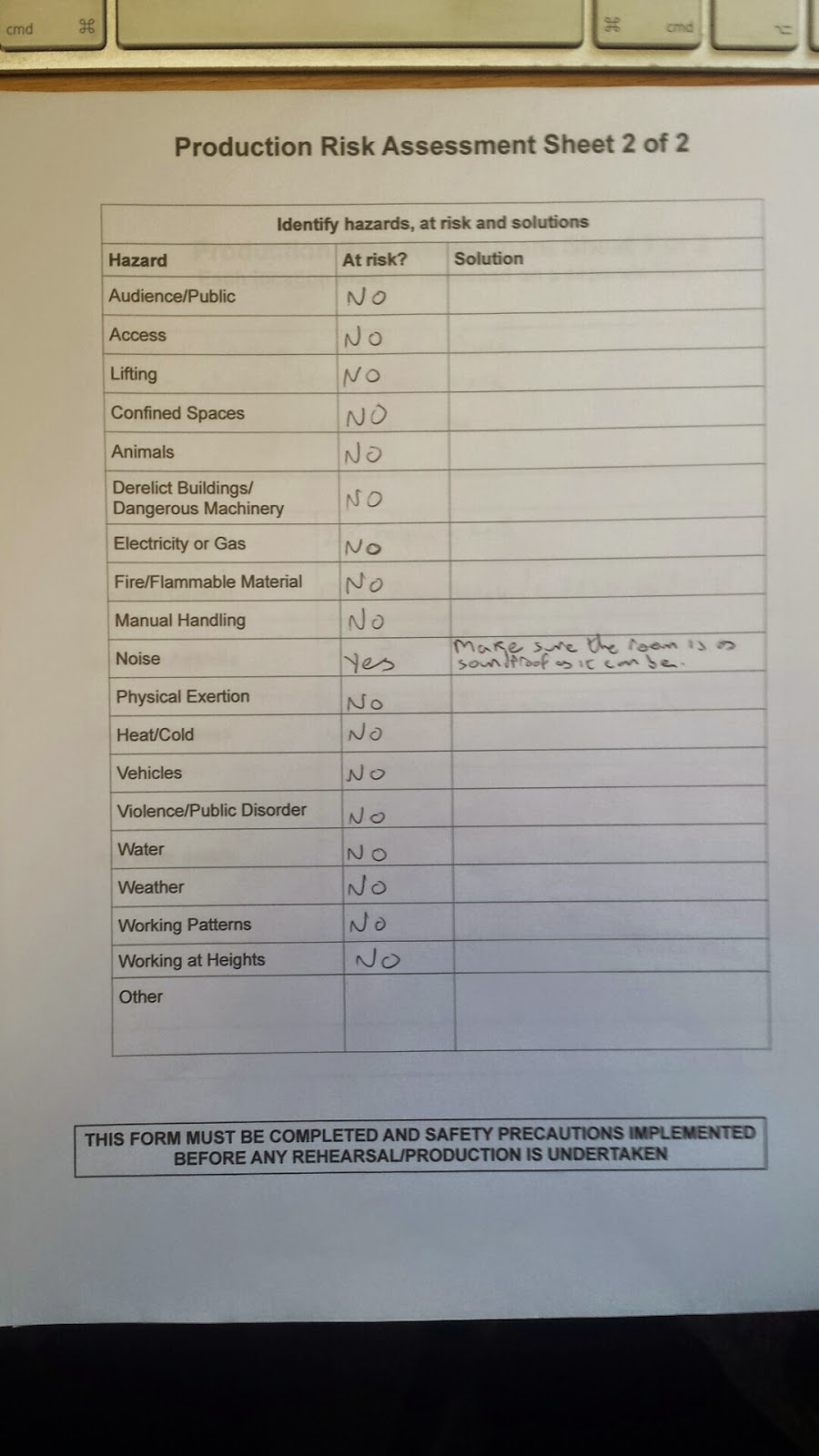
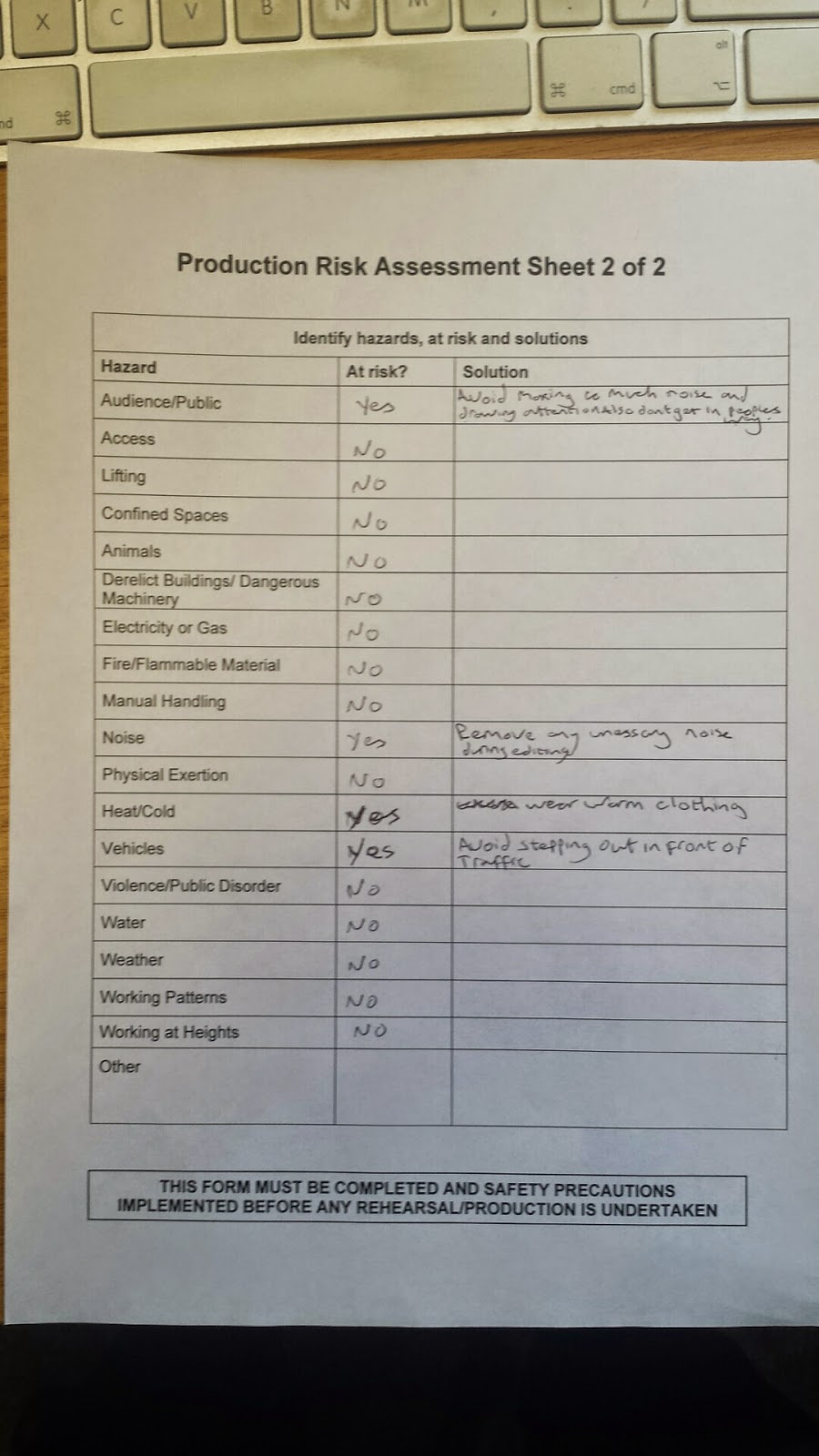
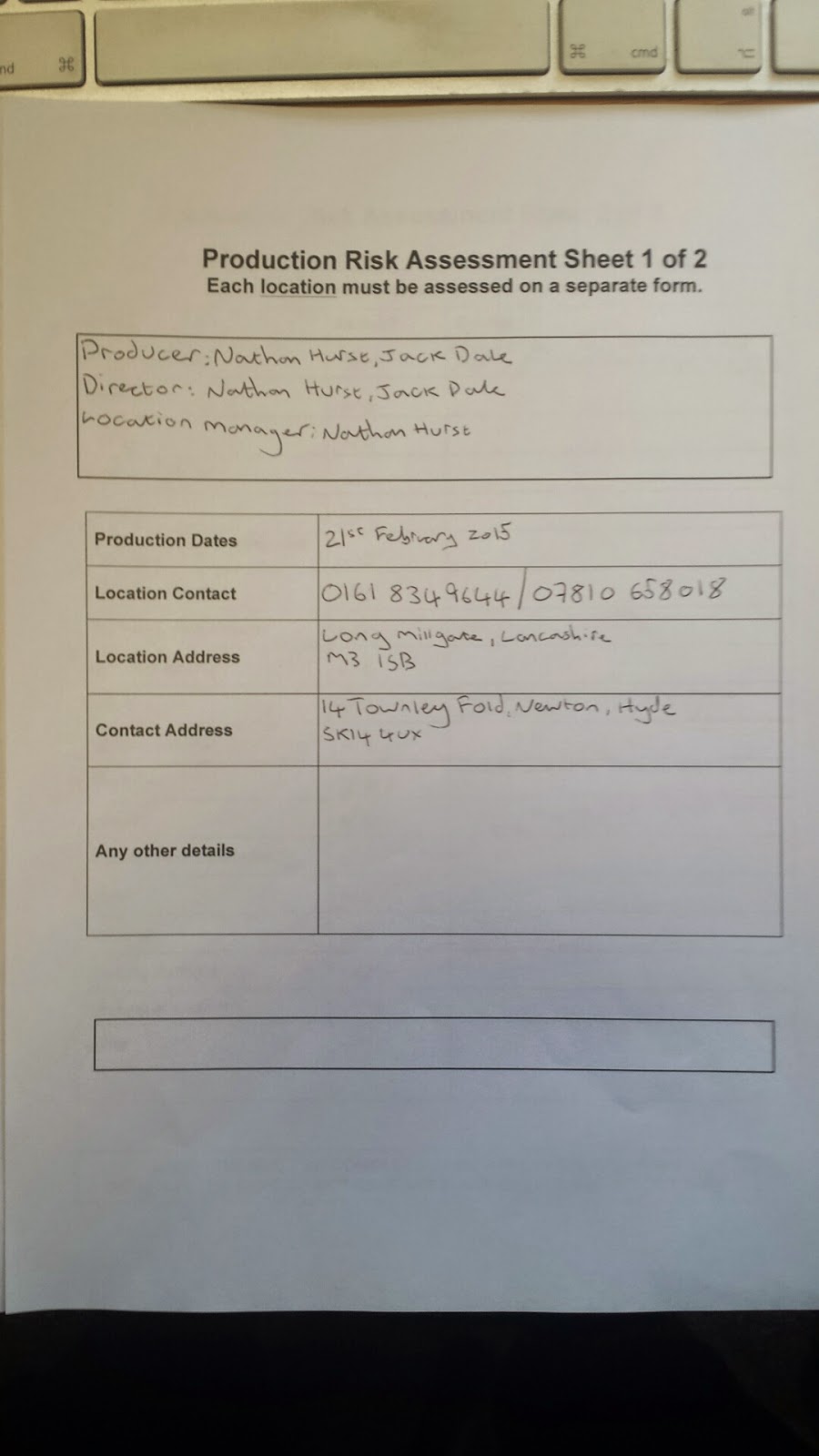
For my production paperwork i created two risk assessments for the two locations i will be filming at. The paper work consists of hazards that could possibly occur during filming, and what i would do to over come and solve these problems. The first two sheets are for lewis's house where i will be filming observational footage and interviews, I only came across one hazard which was excessive noise from the piano which i will solve by removing any unnecessary noise during the editing. The date i will be filming is the 18th February 2015. The next two sheets are risk assessments for Chethams School of Music where i will be filming exterior shots of the college outside and due to this i came across multiple hazards such as Vehicles, Heat/Cold, Noise, and Audience/Public. I will be filming on the 21st February 2015.
Monday, 9 February 2015
Unit 27.3 Be able to plan and research a factual programme for television: Actor release form
For my production paperwork i got my Actor/performer to fill in and sign an Actor release form to give me permission to film them in my documentary and for the film to be exhibited in anywhere in Hyde Clarendon 6th Form College.
Unit 27.3 Be able to plan and research a factual programme for television: Recce
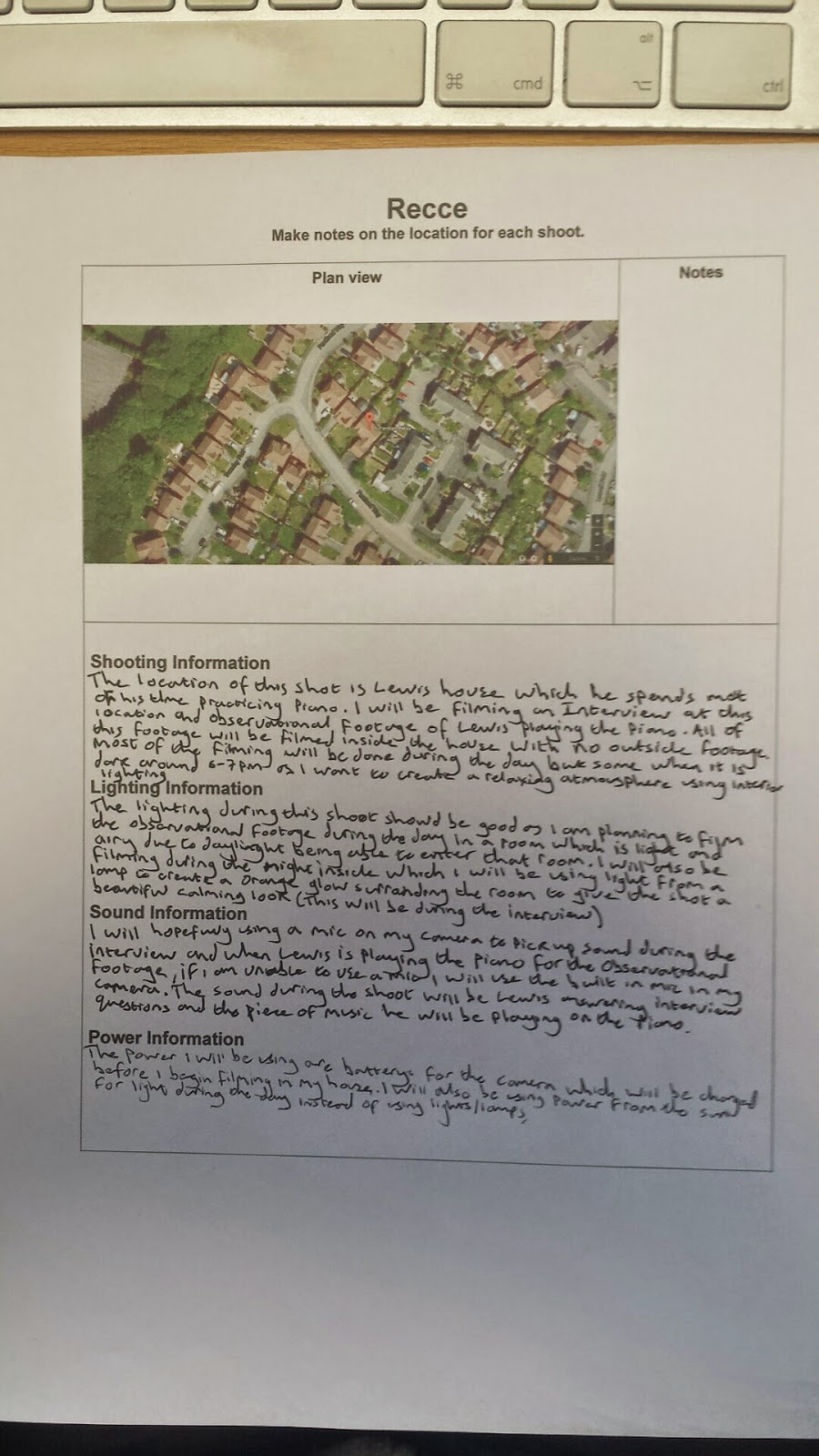
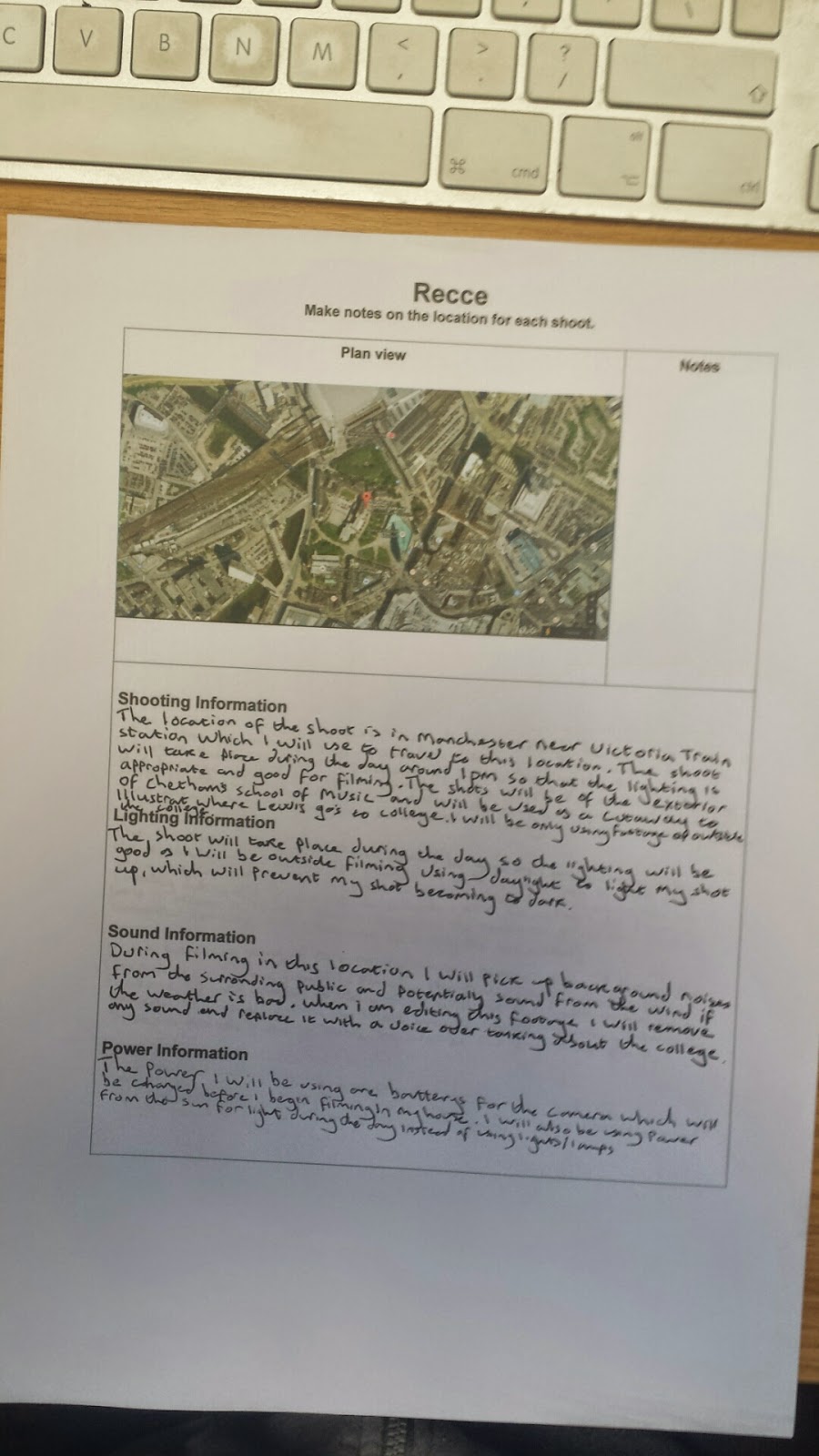
As part of my production paperwork i have created two recce's for filming my documentary. The information these two recce's contain are information on Shooting (filming), Lighting, Sound, and Power for the locations i have chosen to film my documentary at. The first location i have filled in a recce document for is Chethams School Of Music which i will be filming exterior shots of the college as cutaways during my documentary and the second recce being for the location of Lewis house where i will be filming inside the house for observational footage of Lewis playing the piano and interviews with him. Both of the these recce's contain information on the conditions i will be filming in such as the different kinds of light and sound i will have to deal with or use to get the best shots possible and what i will be filming in them locations etc.
Unit 27.3 Be able to plan and research a factual programme for television: Week 2 Production log
Week 2
During this week i hope to complete Recce documents for both of the locations i will be filming at which will be exterior shots of Chethams School Of Music in Manchester and Lewis's house. The Recce's will contain information about what i will be filming, The lighting of the locations, The sound of the locations and information on power.
I also hope to get my actor release form filled in so that i have permission to film Lewis and are able to create my documentary. I will produce a shooting schedule so that i am able to keep track of when i will film so that i am able to get my documentary finished before the deadline.
During this week i hope to complete Recce documents for both of the locations i will be filming at which will be exterior shots of Chethams School Of Music in Manchester and Lewis's house. The Recce's will contain information about what i will be filming, The lighting of the locations, The sound of the locations and information on power.
I also hope to get my actor release form filled in so that i have permission to film Lewis and are able to create my documentary. I will produce a shooting schedule so that i am able to keep track of when i will film so that i am able to get my documentary finished before the deadline.
Wednesday, 4 February 2015
Unit 27.3 Be able to plan and research a factual programme for television: Storyboards for narrative
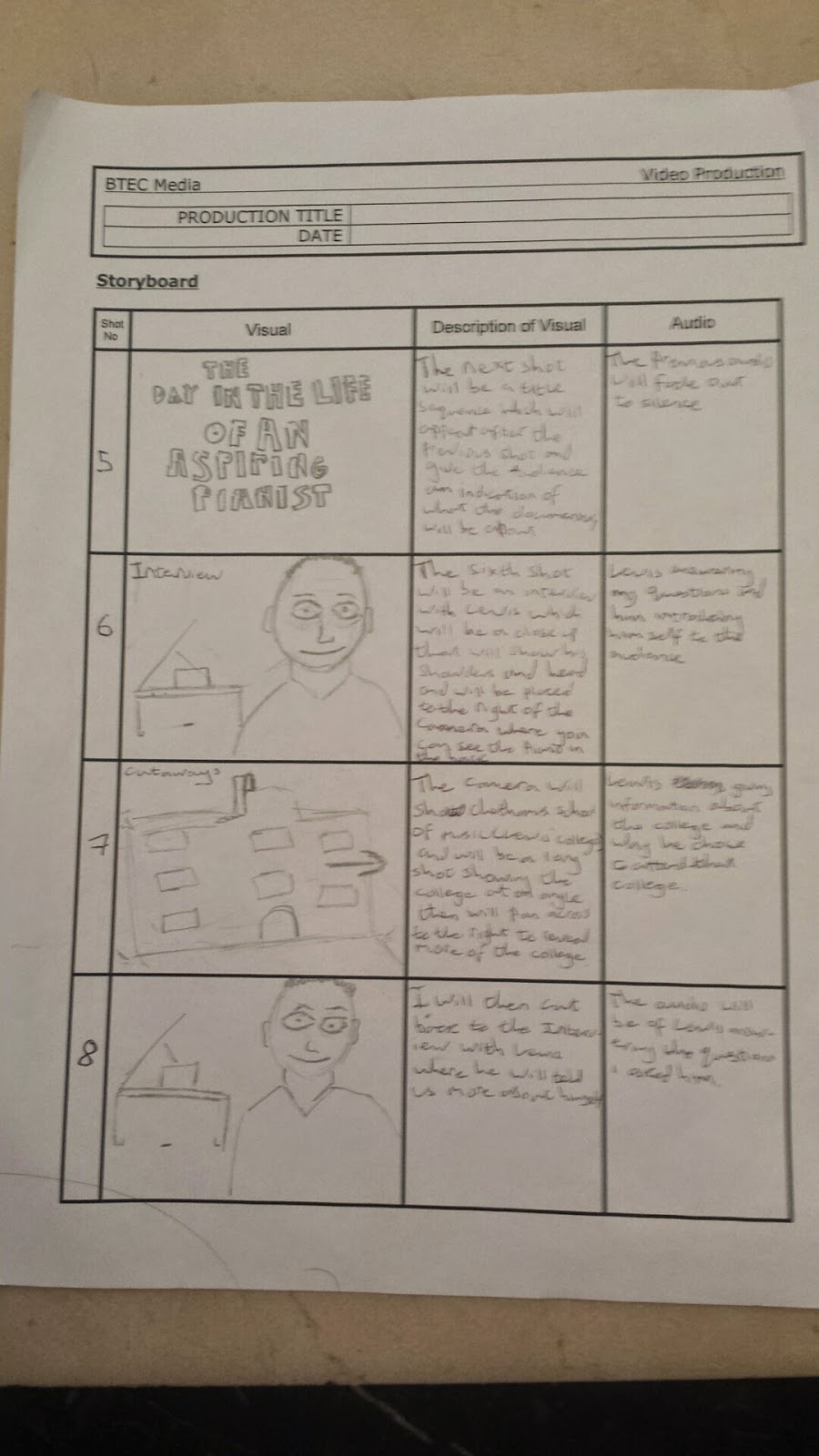
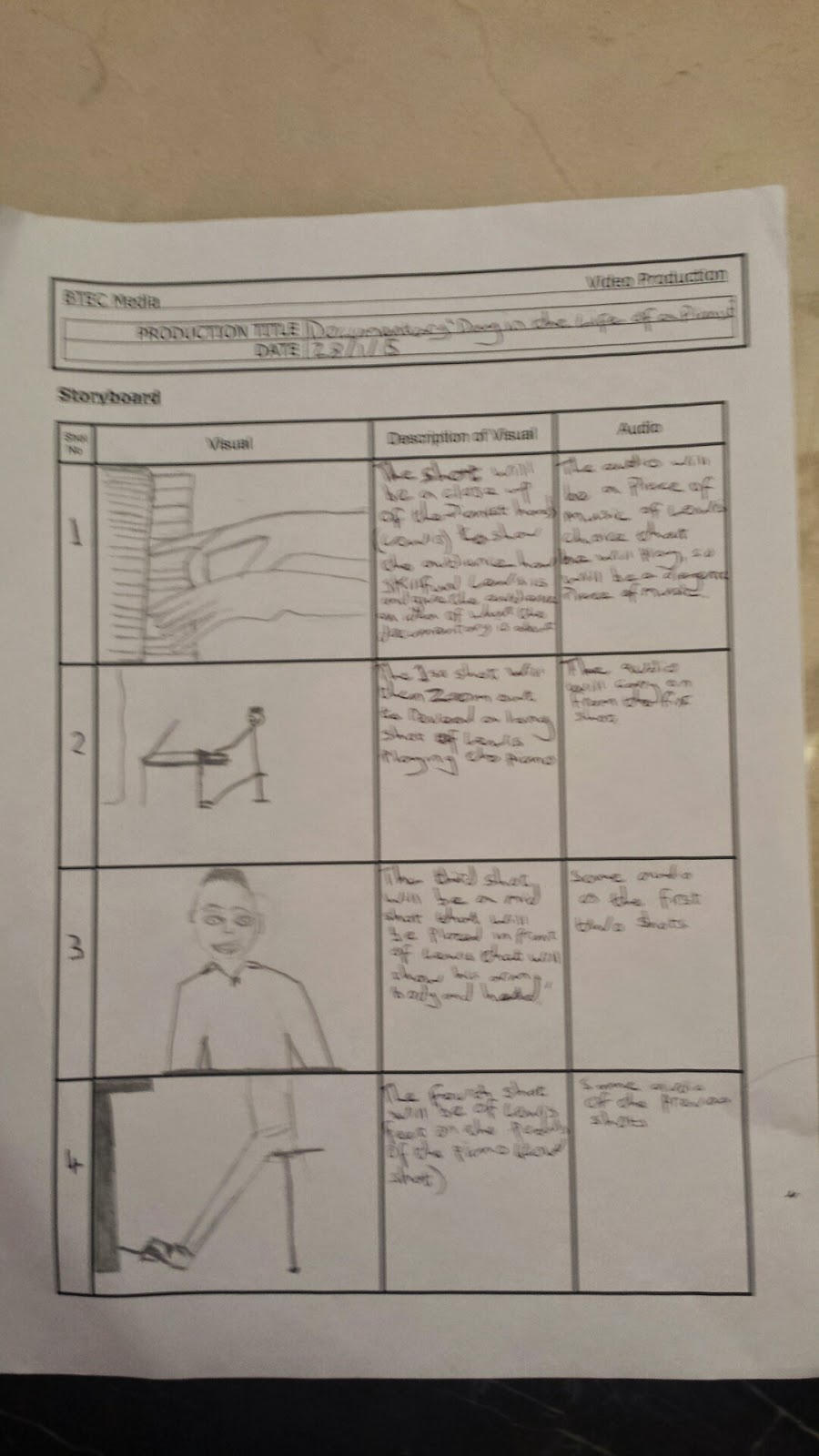
As part of production and planning of my documentary i created storyboards to help me with filming due to the storyboard containing a description and illustration of the camera shots i am going to use and the audio that will be playing during them shots. The storyboards will help with the filming schedule as i will know what shots to film without me going over or under the time i have to film my documentary due to me possibly making mistakes and re filming shots which these storyboards will prevent. It will also stop me getting distracted or going of track with filming aspects which are not necessary or relevant to a certain scene in my documentary or making shots longer than they should be, I can prevent this by referring back to these storyboards during filming.
Tuesday, 3 February 2015
Unit 27.3: Be able to plan and research a factual programme for television: Genre/Proposal: Idea, Content/style, Audience, Place in schedule
Idea: My documentary idea is called 'The day in the life of a pianist', my
documentary will follow an aspiring, professional pianist Lewis Peart to see
how much time he spends practicing the piano and what his daily routine
consists off such of how he balances his social life with his dedication to
become a professional pianist. My documentary will show one individual person
creating his own path to having a career as a professional concert pianist. My documentary will be around 4-7 minutes long so that i am able to give and show the audience every aspect of Lewis life and make them connect in some way with Lewis to make the documentary more interesting.
Content/style: The content of my documentary will follow a journey/factual human interest style documentary due to it following the life of one particular person and the journey he is taking to become a professional pianist, The documentary will hopefully evoke emotion in the audience and make them relate to Lewis and inspire them to follow a career path they want to take. My documentary will include several codes and conventions of documentary film making such as observational footage/cutaways, Interviews, and a Voice over. The observational footage I will use will be cutaways of Lewis playing the piano and footage of his home and college to compare the different environments he plays the piano in. The observational footage will illustrate and show the audience what and how Lewis plays the piano to give the audience a better understanding of the skill and effort Lewis puts into playing the piano. I will also use observational footage to make my documentary look and feel more authentic and professional. I also intend to use observational footage to make my documentary more interesting for the audience instead of just using footage of interviews with Lewis. The style of the observational footage will look and feel as beautiful as the music that is associated with the piano due to me wanting the audience to be able to connect with the music and Lewis and to also make them be inspired to play the piano or some form of instrument.
Content/style: The content of my documentary will follow a journey/factual human interest style documentary due to it following the life of one particular person and the journey he is taking to become a professional pianist, The documentary will hopefully evoke emotion in the audience and make them relate to Lewis and inspire them to follow a career path they want to take. My documentary will include several codes and conventions of documentary film making such as observational footage/cutaways, Interviews, and a Voice over. The observational footage I will use will be cutaways of Lewis playing the piano and footage of his home and college to compare the different environments he plays the piano in. The observational footage will illustrate and show the audience what and how Lewis plays the piano to give the audience a better understanding of the skill and effort Lewis puts into playing the piano. I will also use observational footage to make my documentary look and feel more authentic and professional. I also intend to use observational footage to make my documentary more interesting for the audience instead of just using footage of interviews with Lewis. The style of the observational footage will look and feel as beautiful as the music that is associated with the piano due to me wanting the audience to be able to connect with the music and Lewis and to also make them be inspired to play the piano or some form of instrument.
Another convention I will be using is interviews. Throughout my documentary I will show footage of interviews with Lewis, I intend to use interviews is to give the audience more insight into the reasons why Lewis wants to become a professional pianist and information about how he started playing the piano. Interviews also are one of the main convention in documentary film making as they focus on the specific person the documentary may be on or to give information on what the documentary’s subject is which is what I want to achieve in my documentary due to my documentary being on one person and his journey to become a professional pianist.
The final convention I will be using is a voice over. The reasons I will be using a voice over is to narrate the situations and give information to the audience about the footage being shown such as facts and figures about Lewis or develop on the information he has given in the interview. The voice over that I will be using will also be the answers to the questions that I am asking Lewis in the interview over certain footage to make the documentary more interesting. The voice over will be soft spoken and relaxed to match the elegance of the music and to also make the audience feel relaxed and comfortable as well so that they are able to listen to the information that is being said.
Audience: From my previous research i have found that my documentary idea will appeal most to an older audience such as people who are in the age bracket 40+ or who are interested in the piano and the music it creates. I also found that my audience will be mostly lower to upper middle class due to the people i asked working in a form of managerial job and that people who are middle to upper middle class are the type of people who are interested in these type of documentaries and would find similar interest in watching documentaries with the same types of themes as my documentary. Looking at the NRS social grade i found my audience would fit into these category's: Grade A (Upper middle class), Grade B (Middle Class), and Grade C1 (Lower middle class).
Place of schedule: My documentary will be broadcasted and aired on the BBC at around 6pm-7pm due to that being prime time for my audience to watch the TV as they would of finished work and possibly eating their tea in front of the TV. I chose the BBC for my documentary due to the BBC being the place in which documentaries of my style and genre will be shown and where my audience are most likely to go to to watch this type of documentary instead of turning to channels such as channel 4 which show mostly comical and less serious documentary's that appeal to a wider less specific audience whereas documentary's shown on the BBC appeal to more specific interests of their audiences such as documentary's that focus on musicians.
Audience: From my previous research i have found that my documentary idea will appeal most to an older audience such as people who are in the age bracket 40+ or who are interested in the piano and the music it creates. I also found that my audience will be mostly lower to upper middle class due to the people i asked working in a form of managerial job and that people who are middle to upper middle class are the type of people who are interested in these type of documentaries and would find similar interest in watching documentaries with the same types of themes as my documentary. Looking at the NRS social grade i found my audience would fit into these category's: Grade A (Upper middle class), Grade B (Middle Class), and Grade C1 (Lower middle class).
Place of schedule: My documentary will be broadcasted and aired on the BBC at around 6pm-7pm due to that being prime time for my audience to watch the TV as they would of finished work and possibly eating their tea in front of the TV. I chose the BBC for my documentary due to the BBC being the place in which documentaries of my style and genre will be shown and where my audience are most likely to go to to watch this type of documentary instead of turning to channels such as channel 4 which show mostly comical and less serious documentary's that appeal to a wider less specific audience whereas documentary's shown on the BBC appeal to more specific interests of their audiences such as documentary's that focus on musicians.
Monday, 2 February 2015
Unit 27.3 Be able to plan and research a factual programme for television: Equipment List
For filming my documentary i will be using a Canon EOS 700D camera to catch all of my footage i will be using within my documentary.
The next piece of equipment i will be using is a tripod so that i am able to frame my shots and interviews correctly without the camera moving to much which will effect the quality of my shot.
So that my audio is clear during interviews and to catch the music of the piano i will be using a zoom mic.
The next piece of equipment i will be using is a tripod so that i am able to frame my shots and interviews correctly without the camera moving to much which will effect the quality of my shot.
So that my audio is clear during interviews and to catch the music of the piano i will be using a zoom mic.
Unit 27.3 Be able to plan and research a factual programme for television: Week 1 Production log
Week 1
During the first week of production i will complete a finished storyboard to illustrate the shots i will use and an idea of how my documentary will look and feel due to the storyboards having a step by step visual and story to how my documentary will pan out.
I will also be completing my Genre/Proposal for my documentary which will include My idea, Content/Style of my documentary such as how it is going to look, what type of documentary it is going to be and what the documentary will contain, The Audience which is who and why I'm going to target a specific audience for my documentary and who it will appeal to, and Place in schedule which is what channel i will broadcast my documentary on and the time it would be shown to suit my target audience.
Wednesday, 28 January 2015
Codes and conventions of factual programming for television: Presentation
This is my presentation on 'Codes and Conventions of factual programming for television'. The presentation consists of two examples to give the audience a better understanding of what codes and conventions are used to create documentary film making and the news, The two example i used are 'Johns not mad' for the documentary and the 'BBC news at 10' for the news example.
The first slide of my presentation consists of an overview of my documentary 'Johns not mad' and what the documentary is about, it also shows the audience what codes and conventions are used within documentary filmmaking and this documentary. The codes and conventions i gave information on are observational footage, voice overs and interviews as i felt these were the most prominent codes and conventions used in a documentary. Then the following slides develop on the codes and conventions to give the audience a better understanding and knowledge of them. I also used images to illustrate what i was saying such as images of John doing his daily routine for observational footage and shots of the different interviewees for the information on the interviews slide.
I then went on to talk about 'BBC news at 10' and the first slide i did on the news example was a short explanation on what the 'BBC news at 10' was about and what codes and conventions were used such as news reporters, interviews, voice overs, hard and soft news, and graphics (facts and figures). I then go onto develop on these codes and conventions the same as i did with my documentary examples so that the presentation correlates between the two types of examples so that it looks and feels organised. I also used images to illustrate the information i was given, this was used to make my presentation more entertaining and interesting. Throughout the presentation i also labeled the images to let the audience know what the images were about.
Tuesday, 13 January 2015
Documentary idea rationale
My documentary idea is called 'The day in the life of a
pianist', my documentary will follow an aspiring, professional pianist Lewis Peart
to see how much time he spends practicing the piano and what his daily routine
consists off such of how he balances his social life with his dedication to
become a professional pianist. My documentary will show one individual person creating
his own path to having a career as a professional concert pianist.
The conventions I intend to use for this documentary are
Observational footage, interviews, and a voice over. The observational footage I
will use will be cutaways of Lewis playing the piano and footage of his home
and college to compare the different environments he plays the piano in. The
observational footage will illustrate and show the audience what and how Lewis
plays the piano to give the audience a better understanding of the skill and
effort Lewis puts into playing the piano. I will also use observational footage
to make my documentary look and feel more authentic and professional. I also
intend to use observational footage to make my documentary more interesting for
the audience instead of just using footage of interviews with Lewis.
Another convention I will be using is interviews. Throughout
my documentary I will show footage of interviews with Lewis, I intend to use
interviews is to give the audience more insight into the reasons why Lewis
wants to become a professional pianist and information about how he started
playing the piano. Interviews also are one of the main convention in documentary
film making as they focus on the specific person the documentary may be on or
to give information on what the documentary’s subject is which is what I want to achieve in my documentary
due to my documentary being on one person and his journey to become a
professional pianist.
The final convention I will be using is a voice over. The
reasons I will be using a voice over is to narrate the situations and give
information to the audience about the footage being shown such as facts and
figures about Lewis or develop on the information he has given in the interview.
The voice over that I will be using will also be the answers to the questions
that I am asking Lewis in the interview over certain footage to make the
documentary more interesting.
My documentary idea will deal with issues relating to
factual programming by being impartial and objective towards the subject being
shown. This is due to the documentary dealing with one person’s aspirations of
becoming a professional pianist and shouldn't be shown in a prejudice way such
being biased and subjective with my opinion but allowing Lewis to give his own
information and view on it due to many different documentaries not being subjective
and voicing the opinions of the presenters. My documentary will only show the
facts and opinions of Lewis as the documentary is about him and his daily life.
Wednesday, 7 January 2015
BBC news at 10 analysis
Codes and conventions
News reporters are used through out the news such as the use of a male reporter who is situated in a studio in which he gives the headlines and information about the news that is occurring and relevant. Another reporter that is used is a female field reporter who elaborates on the news that is happening.
Voice overs are used over cutaways and observational footage such as to give information on the news which is being reported. The cutaways/Observational footage which are used relate to the news being broadcasted such as giving more elaborate and illustrated information on the story.
Interviews are used also during the news such interviews with experts and witnesses to give information of the subject being reported. Interviews with experts are with people who have knowledge on what is being reported on such as doctors, whereas witnesses are people who are the general public who do not have a wide understanding of the subject but who have happened to see and witness it.
The news have a mixture of hard and soft news. Hard news which is reported is things such as big news that is important and is life affecting news, whereas soft news is news which is not as important and is more for entertainment purposes.
Facts and figures are shown through graphics to give the audience a better understanding of the news and to make it more entertaining and visually appealing so that they do not become disinterested The facts and figures being shown are quantitative and qualitative research. Graphics are also used in the studio behind the reporter which relate to the news.
News reporters are used through out the news such as the use of a male reporter who is situated in a studio in which he gives the headlines and information about the news that is occurring and relevant. Another reporter that is used is a female field reporter who elaborates on the news that is happening.
Voice overs are used over cutaways and observational footage such as to give information on the news which is being reported. The cutaways/Observational footage which are used relate to the news being broadcasted such as giving more elaborate and illustrated information on the story.
Interviews are used also during the news such interviews with experts and witnesses to give information of the subject being reported. Interviews with experts are with people who have knowledge on what is being reported on such as doctors, whereas witnesses are people who are the general public who do not have a wide understanding of the subject but who have happened to see and witness it.
The news have a mixture of hard and soft news. Hard news which is reported is things such as big news that is important and is life affecting news, whereas soft news is news which is not as important and is more for entertainment purposes.
Facts and figures are shown through graphics to give the audience a better understanding of the news and to make it more entertaining and visually appealing so that they do not become disinterested The facts and figures being shown are quantitative and qualitative research. Graphics are also used in the studio behind the reporter which relate to the news.
Documentary-Johns not mad
Codes and conventions
The documentary 'Johns not mad' uses several codes and conventions of documentary film making. The codes and conventions are:
Observational footage, the documentary uses mainly observational footage of John to show how he copes with everyday life and how he copes with his Tourettes, This is used to go into more depth about Johns life and give the audience a better understanding of Tourettes and what it is.
Voice over, Voice overs are used to narrate the situations that johns facing and his struggles in his daily life. The voice over is female due to the voice being more sympathetic.
Interviews, Interviews are used through out the documentary. The interviews used are with John, Johns mum, and an expert, the interviews with John give the audience an insight to how John feels to such as Tourettes affects his daily life and how he has to cope with it, The interview with his mum is on how she has to cope with coming to terms with johns condition. The Experts interview gives the audience more information on the Tourette's condition, Experts interviews act as the voice of god and give more information and facts on Tourettes.
Subscribe to:
Comments (Atom)












